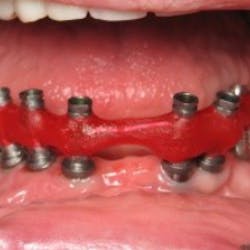One of the most challenging issues with implant patients is proper dental implant maintenance. Many patients think that since they cannot get dental decay on implants, they do not have to worry about cleaning around them like they would a natural tooth. We all know that is a false assessment. Lack of proper implant maintenance can lead to peri-implantitis, which, in turn, can lead to failure of the prosthesis altogether. It is imperative to persuade these patients to practice good oral hygiene procedures at home as well continue appropriate implant maintenance visits. Sometimes we do not make this clear enough. Perhaps it is because we simply don’t have a strict enough regimen implemented in our own practices. Due to various health conditions, some patients may need to be seen more often than others. Or, how can we get these patients to say “yes” to periodontal therapy when peri-implantitis begins to develop? The goal is to educate patients on how these visits help prevent implant failure and save their remaining natural teeth. Patients are usually not on board with getting any other kind of “cleaning” than a traditional prophy, so what steps can we take to fix this?Add value to your periodontal programMost patients tend to resist the recommendation of periodontal therapy because they do not understand the value in it. As for your staff suggesting the procedure, they may not even give it half a thought, because they expect the patient to deny treatment. To first persuade a patient, you must persuade all of your staff—including everyone from your hygienists to your receptionists.
Oftentimes, patients do not comprehend why they need periodontal therapy and all of the benefits that it can provide for their oral health. If your staff can effectively educate patients on the value of maintaining implant pocket depths and back up your recommended treatment, then your patient is more likely to accept that the procedure truly is necessary. Remind your patients of their implant investmentImplants can last for a lifetime, but only if they are maintained properly. Your patient has already spent months, if not years, getting implants. Remind him that in order to preserve the implant suffering from peri-implantitis, it is vital to perform more than just a “routine cleaning” to get his oral health back to where it needs to be. Then—and only then—can your patient continue maintaining the implant on his own along with a routine biannual preventive schedule. All the patient can see is that the dollar amount of “regular” dental cleanings is covered twice per year by dental insurance. If we suggest any kind of dental cleaning other than a prophy, the patient’s first question is usually, “Will this be covered by my dental insurance?” While most insurance carriers will cover periodontal scaling and root debridement procedures (D4341 code), there are many restrictions and payment requirements. It is crucial to have the proper documentation to prove to the insurance carrier that your patient does, in fact, need to have therapy to help treat the periodontal disease or peri-implantitis.
What are some ways we can improve the chance of insurance providers covering nonsurgical periodontal therapy?It is very important to thoroughly chart at each appointment: probing depths, tooth mobility, bleeding, furcations, and areas where loss of attachment is present—even around dental implants. If you can show through your probing chart documentation that periodontal disease or peri-implantitis is present or has progressed with each appointment, then the patient’s insurance carrier can verify that your patient does have periodontal disease. In most cases, the patient’s insurance carrier will likely cover the periodontal therapy procedure if they haven’t had that treatment performed within the previous two to three years.Implement stricter implant maintenance appointmentsRemember, implant-probing sites may still be considered “healthy” at up to 5 mm deep.
So maintenance of the peri-implant pocket is extremely important. Waiting too long for the pocket to evolve any further may otherwise cause your patient to lose the implant altogether. That’s why it’s such a good reason to place implant patients on a stringent recall from the initial installation process. How can we as dental professionals encourage our patients to agree to periodontal therapy?
- Educate your patient about the cause of peri-implantitis.
- Explain the value and benefits of regular periodontal therapy.
- Have your patients commit to a three- to four-month maintenance program prior to the implant installation.
- Discuss the long-term advantages of periodontal therapy and follow-up maintenance procedures to preserve your patients’ implants, as well as their natural teeth.
Conclusion
When you recommend periodontal therapy to your patients, use their dental x-rays to show them their bone loss. Share their probing depths with them and let them know what their deep pockets mean. If possible, use illustrations and displays to show them measurements, as many people are visual learners. Then explain what happens when peri-implantitis or periodontal disease progresses.
Remind your patients that the investment they made for their implants can be lost if their periodontal condition is not treated, since implant failure and tooth loss can occur in a short amount of time. Stress that all of your staff members are on board with emphasizing the need and benefits of a set periodontal program in your practice.
Together, you and your patients can work together to prevent the progression of their peri-implantitis, once they realize the importance and value of periodontal therapy.
Editor’s note: This article originally appeared in Perio-Implant Advisory, a chairside resource for dentists and hygienists that focuses on periodontal- and implant-related issues. Read more articles and subscribe to the newsletter.







